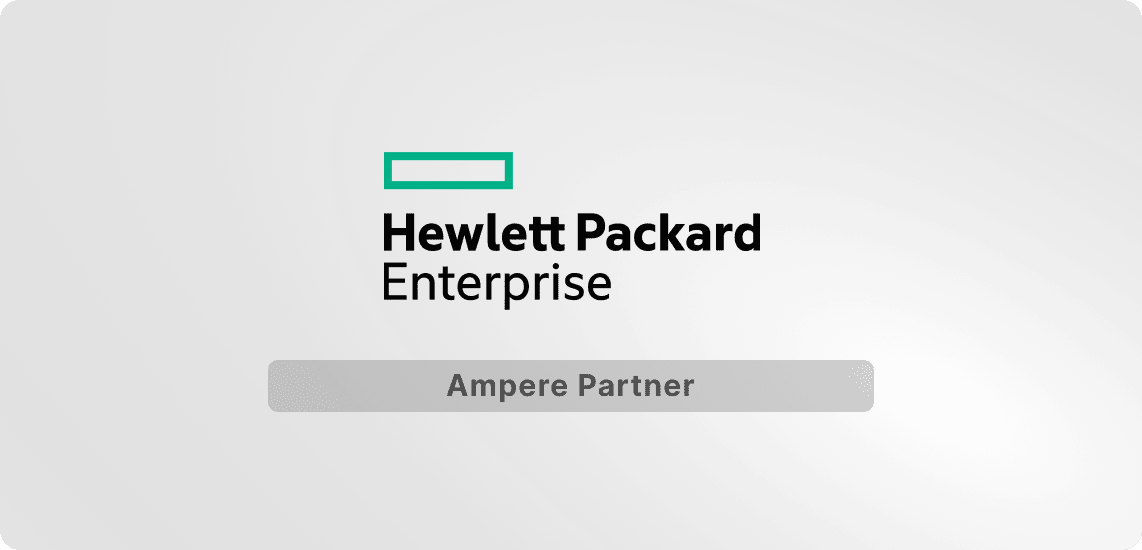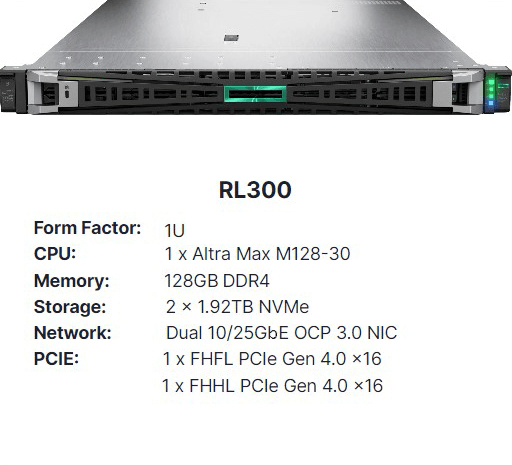
Hewlett Packard Enterprise
The HPE ProLiant RL300 Gen11 features the Ampere® Altra® and Ampere® Altra® Max processors designed for predictable frequency scaling to lessen the impact of problems like noisy neighbors. Performance for traditional applications has often been measured by average latencies, but cloud-native workloads with high levels of inter-process communication require more granular latency management.
A large CPU core count allows for higher datacenter density, allowing service providers to extract even more revenue out of their CapEx. With high power efficiency, businesses can eliminate underutilized rack space in their datacenter with a platform that can also be deployed into power-constrained edge environments.
With up to 128 core count per socket, the HPE ProLiant RL300 has high core density to deliver high performance and power efficiency.
AI Inference Server
AI Inference Server

GPU-Free AI Inference on the HPE RL300 ProLiant Gen11
The HPE ProLiant RL300 Gen11 Server for AI Inference is the first AI platform in the HPE ProLiant family that delivers leading AI Inference performance without the use of GPUs.
Learn More
Visit the Ampere AI homepage for more information about Ampere’s innovations in this space and for access to our software packages: AI Solutions Home
New Smart Buy BTO Offer from HPE
Platform Management
Platform Management
HPE iLO
- Consistent experience across the HPE ProLiant Portfolio
- Security and performance through the HPE server management capabilities including Silicon Root of Trust, Server Configuration Lock, and more
OpenBMC
- Pursue and expand your open-source strategy
- Open, flexible design by leveraging the OpenBMC community to build, grow, and maintain your implementation, on your timeline and with resources you control
Resources
Resources
Blogs & Announcements
Blog
CloudSigma Ampere-based Compute
CloudSigma
Blog
Arm saves cost and power for EDA with HPE RL300 Gen11 - Infrastructure Solutions blog - Arm Community blogs - Arm Community
Sep, 2024
ARM
Blog
HPE ProLiant RL300 Gen11 server certified with Oracle Linux to help customers deliver cloud native solutions
Jul, 2023
Oracle
Blog
MAIN launches infrastructure based on Ampere processors
MAIN
Press Release
phoenixNAP powers expanded AI and cloud services with energy-saving, Ampere-based servers from Hewlett Packard Enterprise
Aug, 2023
HPE
Press Release
SKT launches low-cost, high-efficiency cloud infrastructure
Aug, 2023
Pulse
Briefs
Customer Stories
Customer Story
MAIN private Cloud for hosting IFS Cloud for furniture manufacturer, Mikomax
Oct, 2024
MAIN
Informaniak Boosts Power Efficiency and Challenges Performance Consistency with Ampere® Powered Server
Ampere
Customer Story
Improve carbon neutrality by reducing server power consumption – NTT Data Group Corporation
Aug, 2023
HPE
Press Release
phoenixNAP powers expanded AI and cloud services with energy-saving, Ampere-based servers from Hewlett Packard Enterprise
Aug, 2023
HPE
Customer Story
How phoenixNAP Delivers First-to-Market Tech for the Best Price
Sep, 2023
phoenixNAP
Customer Story
A Match Made in the Cloud: CloudSigma’s Ampere Adventure
Nov, 2023
Robert Jenkin - CEO at CloudSigma
Blog
The HPE ProLiant RL300 Gen 11 server: A game-changer for CloudSigma
Jan, 2023
HPE ComputeExperts
Publications
Whitepaper
A Deep-Dive into HPE ProLiant RL300 Gen11 Performance Leadership
HPE
Whitepaper
Gorilla Guide - How HPE ProLiant RL300 Gen11 Delivers Density Efficiency and a Reduced Footprint
Aug, 2024
HPE
White Paper
Next generation of flexible, efficient, cloud-native compute
HPE
White Paper
Power Saving for Java Applications using Ampere servers
Nov, 2023
NTT DATA
Webinar
How to Triple Efficiency, Double Performance, and Save in Your Data Center
Ampere
Chalk Talk
The HPE ProLiant RL300 Gen11
HPE
Video
HPE ProLiant RL300 Gen11, compute engineered for a hybrid world: scale-out performance
HPE
Info Graphic
Get scale-out performance with unprecedented efficiency
HPE
Info Graphic
Game-changing efficiency for running cloud-native workloads
HPE
Tutorials


